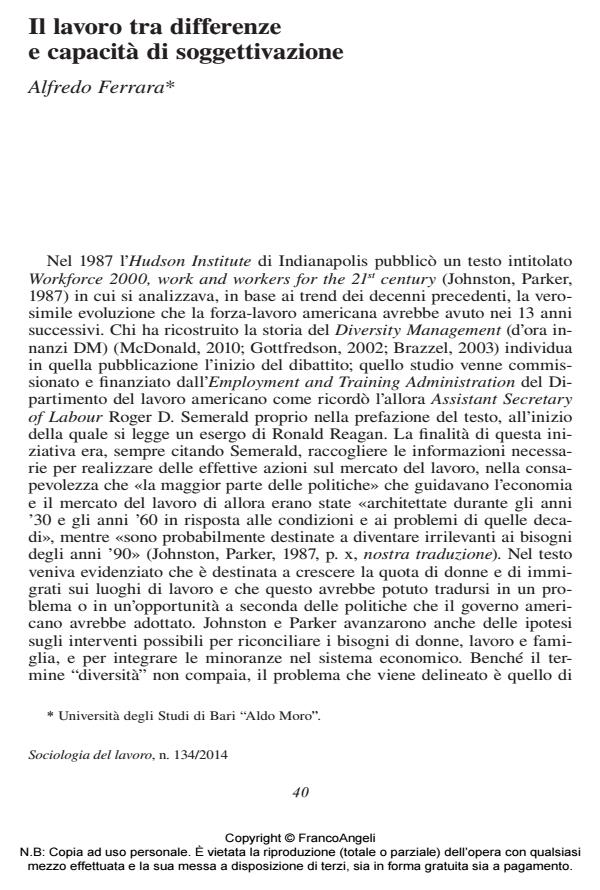Work between differences and ability of subjectification
Journal title SOCIOLOGIA DEL LAVORO
Author/s Alfredo Ferrara
Publishing Year 2014 Issue 2014/134 Language Italian
Pages 14 P. 40-53 File size 109 KB
DOI 10.3280/SL2014-134002
DOI is like a bar code for intellectual property: to have more infomation
click here
Below, you can see the article first page
If you want to buy this article in PDF format, you can do it, following the instructions to buy download credits

FrancoAngeli is member of Publishers International Linking Association, Inc (PILA), a not-for-profit association which run the CrossRef service enabling links to and from online scholarly content.
In the course of the past decades western countries’ workforce has witnessed different phenomena that have deeply transformed its composition, making it more and more heterogeneous; diversity management is what enterprises have offered in response to these new needs; it thus recognizes their legitimacy and turns them into an opportunity in the dynamics of value creation. After offering a picture of the main demographic trends that testify this process of transformation, as well as a short history of diversity management practices, the article focuses on the ambivalence of these very practices. On the one hand, they provide citizenship to the various dimensions of personal and collective identity in workplaces. On the other hand, they take elements of material sharing away from new workers, thus contributing to challenging their ability of subjectification. In doing so, the paper also takes into account the main critiques that have originated from this debate.
Keywords: Keywords: needs, conflict, diversity, diversity management, identity, subjectivity
- Beck U. (1986). Risikogesellschaft - Auf dem Weg in eine andere Moderne, Frankfurt am Main: Suhrkamp Verlag (trad. it.: La società del rischio. Verso una nuova modernità. Roma: Carocci, 2000).
- Boltanski L., Chiapello E. (1999). Le nouvel esprit du capitalisme. Paris: Gallimard.
- Bombelli M.C. (2004). Diversity Management: motivazioni, problematiche e prospettive di utilizzo. In: Mauri L., Visconti L.M., a cura di, Diversity Management e Società Multiculturale. Teorie e Prassi. Milano: FrancoAngeli.
- Brazzel M. (2003). Historical and Theoretical Roots of Diversity Management. In: Plummer D.L., a cura di, Handbook of Diversity Management: Beyond Awareness to Competency Based Learning, Lanham: University Press of America.
- Cox J.T. (1991). The multicultural organizations: theory, research and practice. San Francisco: Berrett-Koehler.
- Dass P., Parker B. (1996). Diversity: a strategic issue. In: Kossek E.E., Lobel S.A., a cura di, Managing Diversity. Human resource strategies for transforming the workplace. Oxford: Blackwell Publishers.
- Fabbri T.M. (2005). E se Donnarumma tornasse all’assalto? Riflessioni sulla gestione delle risorse umane. Sviluppo e Organizzazione, 207, 1: 117-24.
- Fischer M. (1964). Lo sciopero dei metallurgici nel Baden-Würtemberg, Quaderni rossi, Produzione, consumi e lotta di classe, 4: 226-31.
- Gottfredson L.S. (1992). Dilemmas in Developing Diversity Programs. In: Jackson S.E. and Associates, a cura di, Diversity in the workplace. Human Resources Initiative. New York: The Guildford Press.
- Greene A.M., Kirton G. (2004). Views from another stakeholder: Trade union perspectives on the rhetoric of ‘Managing Diversity’, Warwick Papers In Industrial Relations, 74.
- ISTAT, Popolazione residente in età da 6 anni in poi per livello di istruzione e ripartizione geografica ai censimenti – Censimenti 1951-2001.
- Johnston W.B., Packer A.E. (1987). Workforce 2000, work and workers for the 21st century, Indianapolis: Hudson Institute.
- Kamal Y., Ferdousi M. (2009). Managing Diversity at Workplace: A Case Study of Hp, ASA University Review, 3, 2: 157-170.
- Kossek E.E., Lobel S.A., a cura di (1996). Managing Diversity. Human resource strategies for trasforming the workplace. Oxford: Blackwell Publishers. La Macchia C., a cura di (2009). Disabilità a lavoro. Roma: Ediesse.
- Lawler III E.E., Finegold D. (2000). Individualizing the Organization: Past, Present and Future. Organizational Dynamics, 29, 1: 1-15. DOI: 10.1016/S0090-2616(00)00009-7
- Magatti M. (2009). Libertà immaginaria. Le illusioni del capitalismo tecno-nichilista. Milano: Feltrinelli.
- Marchetti S. (2013). Intersezionalita. In: Botti C., a cura di, Le etiche della diversità culturale, Firenze: Le Lettere.
- McDonald D.M. (2010). The Evolution of ‘Diversity Management’in the USA: Social Contexts, Managerial Motives and Theoretical Approaches, Tokyo: Institute of Business Research Daito Bunka University.
- Meyer J.P., Allen N.J. (1991). A three-component conceptualization of organizational committment. Human Resource Management Review, 1, 1: 61-89. DOI: 10.1016/1053-4822(91)90011-Z
- OECD, Health Status, www.stats.oecd.org/Index/.
- OECD, Migration, Inflows of foreign population into OECD countries, www.oecd.org/migration/mig/.
- OECD, Short-Term Labour Market Statistics: Employment Rate, www.oecd-ilibrary. org/statistics/.
- Preterossi G. (2011). La politica negata. Roma-Bari: Laterza.
- Revelli M. (2013). Finale di partito. Torino: Einaudi.
- Ricco R. (2008). Teoria e pratica della gestione della diversita. In Neri M., a cura di, Studi e ricerche sul tema delle relazioni di lavoro. Bologna: Pitagora.
- Ricco R. (2012). Utilizing a new-human relations framework to leverage workforce diversity. In: C. Scott, M. Byrd, a cura di, Handbook of Research on Workforce Diversity in a Global Society: Technologies and Concepts, Hersey: IGI Publisher.
- Solari R. (2004). La gestione delle risorse umane: dalle teorie alle persone. Roma: Carocci.
- Thomas R.Jr. (1990). From Affirmative Action to Affirming Diversity, Harvard Business Review, 68, 2: 107-117.
- Thomas R.Jr. (1991). Beyond race and gender: unleashing the power of your total workforce by managing diversity. New York: AMACON.
- Thomas R.Jr. (1995). A diversity framework. In: Chemers M.M., Oskamp S., Costanzo M.A., a cura di, Diversity in organisations: new perspectives for changing workforce, Newbury Park, Sage publications.
- United States Census Bureau, Historical Time Series Tables on School Enrollment, www.census.gov/hhes/socdemo/education/data/.
- Weech-Maldonado R., Dreachslin J.L., Dansky K.H., De Souza G., Gatto M.
- (2002). Racial/ethnic Diversity Management and cultural competency: the case of Pennsylvania hospitals. Journal of Helthcare Management, 47, 2: 111-26.
- Zanoni P., Janssens M. (2004). Deconstructing Difference: The Rhetoric of Human Resource Managers’ Diversity Discourses, Organization Studies, 25, 1: 55-73. DOI: 10.1177/017084060403818
Alfredo Ferrara, Il lavoro tra differenze e capacità di soggettivazione in "SOCIOLOGIA DEL LAVORO " 134/2014, pp 40-53, DOI: 10.3280/SL2014-134002